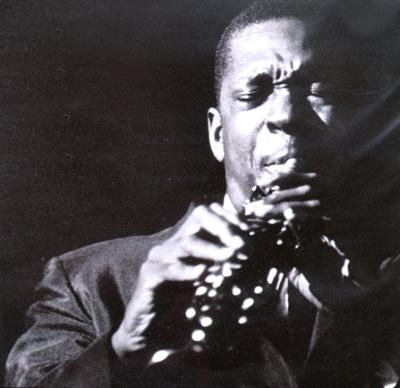Join Curious for an engaging pre-show exploration of The Jazz Infusion: How Coltrane influenced Water by the Spoonful with Lamont School of Music Professor Art Bouton prior to the shows on Sept. 17 and Sept. 29. Details here.

Jazz musician and composer John Coltrane
We like to ask questions at Curious. Here’s one: What does a play sound like?
Our answer for Water by the Spoonful, is jazz. Free jazz. John Coltrane, to be specific.
“I wanted to write a piece about jazz and what that means, feels like, sounds like,” playwright Quiara Alegría Hudes says. “A lot of the piece grapples with harmony and discord. It may sound highfalutin but it’s actually very human, the way we experience harmony and discord.”
This is what happens when a classically trained musician (with a degree from Yale, no less) turns her talents to playwriting. She draws on the vocabulary and structure of music.
In the first of The Elliot Plays, it was a Bach Fugue that inspired the structure and sound of the work. In Water by the Spoonful, the second installment, we jump to the world for free jazz. In the final piece The Happiest Song Plays Last (opening January 14), we’ll explore traditional music of Puerto Rico.
It’s part of the intrigue of this series that we watch the same characters over time, but in very different worlds, stories, and context. Adding the layer of diverse musical idioms makes each play strikingly unique and vividly alive.
“Hudes’ plays have a unique musicality, both in structure and sound,” says Brian Freeland, Curious sound designer for all three of The Elliot Plays. “It’s a great palette for a sound designer to work from. Coltrane’s work veers from smooth and sublime to totally abstract and chaotic.”
Coltrane’s music is often described as ‘sheets of sound’ with a layering of notes. This reflects the variety of characters and relationships in the production. The show has many changes in rhythm, pace, and voice. Brian used Coltrane’s music to punctuate and transition between the scenes of the play. Brian’s design is reminiscent of a film soundtrack, using the dissonance of the jazz to emphasize the separate locations of the play’s characters in an internet chat room and the clashes among and between them.
In a passionate monologue in the play, Yazmin, a professor of music, talks about Coltrane’s music and her passion for it.
Coltrane democratized the notes. He said they’re all equal. Freedom. It was called Free Jazz but freedom is a hard thing to express musically without spinning into noise.
Follow this link to hear what she is describing. Coltrane’s Ascension, 1965.
As the sound designer for three interconnected plays, Brian had a unique challenge. “It’s a great opportunity to develop the sounds across the story and blend some of the ambiance of each show into the next.” If you listen carefully, you may just hear a little Bach from the first show woven in and between the smooth styling of John Coltrane. And a nod to the danza and orquesta jíbara music, featured in part three. (Stay tuned for more about that show and it’s music in an upcoming blog.)
Want to hear more? Check out this playlist of John Coltrane’s best by the Cool Jazz Music Channel.
